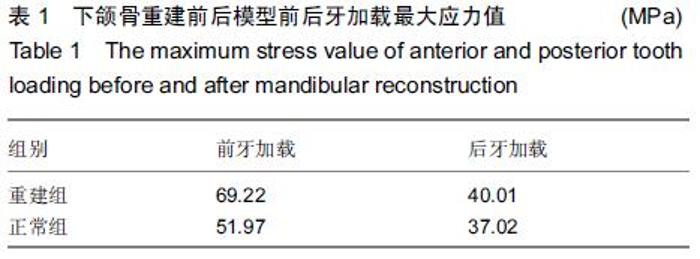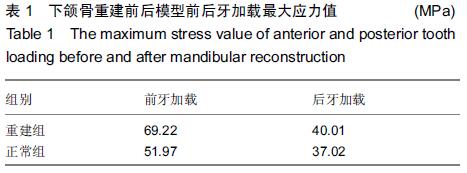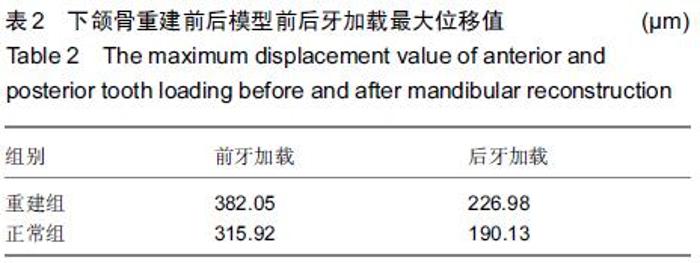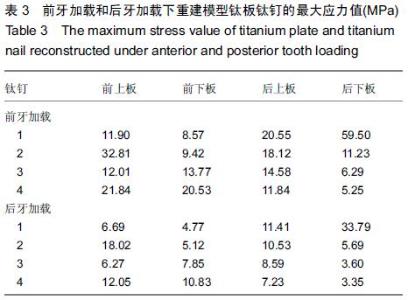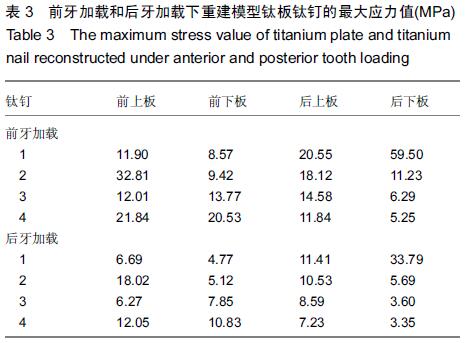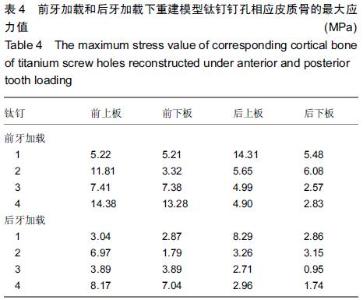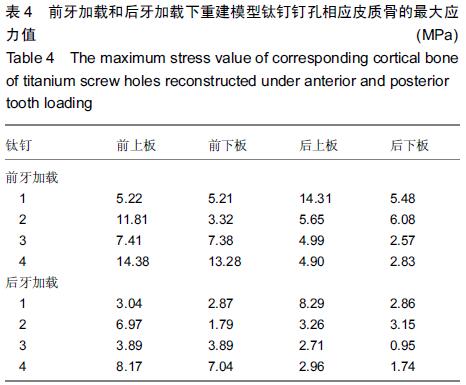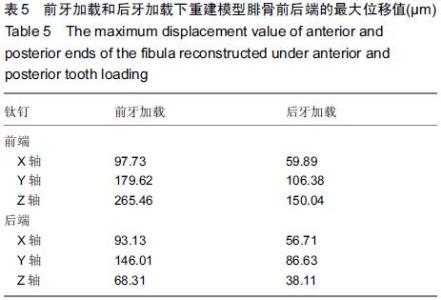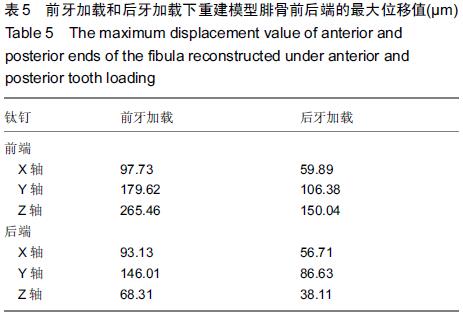Chinese Journal of Tissue Engineering Research ›› 2015, Vol. 19 ›› Issue (47): 7550-7555.doi: 10.3969/j.issn.2095-4344.2015.47.002
Previous Articles Next Articles
Fibula reconstruction and small titanium plate fixation for repair of mandibular body defects: a three-dimensional finite element analysis
Chen Biao, Qu Peng-fei, Liu Yao-qiang, Fan Xu-hui, Liu Ji-lun, Yang Wei
- Department of Oral and Maxillofacial Surgery, the Second Hospital of Hebei Medical University, Shijiazhuang 050000, Hebei Province, China
-
Received:2015-10-06Online:2015-11-19Published:2015-11-19 -
Contact:Yang Wei, Master, Chief physician, Professor, Department of Oral and Maxillofacial Surgery, the Second Hospital of Hebei Medical University, Shijiazhuang 050000, Hebei Province, China -
About author:Chen Biao, Master, Attending physician, Department of Oral and Maxillofacial Surgery, the Second Hospital of Hebei Medical University, Shijiazhuang 050000, Hebei Province, China -
Supported by:the Scientific Research Program of Hebei Province Health Department, No. 20150256
Cite this article
Chen Biao, Qu Peng-fei, Liu Yao-qiang, Fan Xu-hui, Liu Ji-lun, Yang Wei . Fibula reconstruction and small titanium plate fixation for repair of mandibular body defects: a three-dimensional finite element analysis[J]. Chinese Journal of Tissue Engineering Research, 2015, 19(47): 7550-7555.
share this article
| [1] Bilkay U, Tokat C, Helvaci E, et al. Free fibula flap mandible reconstruction in benign mandibular lesions. J Craniofac Surg. 2004;15(6):1002-1009. [2] Zoumalan RA, Hirsch DL, Levine JP, et al. Plating in microvascular reconstruction of the mandible: can fixation be too rigid? J Craniofac Surg. 2009;20(5):1451-1454.
[3] Strackee SD, Kroon FH, Bos KE. Fixation methods in mandibular reconstruction using fibula grafts: a comparative study into the relative strength of three different types of osteosynthesis. Head Neck. 2001;23(1):1-7.
[4] Benlidayi ME, Gaggl A, Bürger H, et al. Comparative study of the osseointegration of dental implants after different bone augmentation techniques: vascularized femur flap, non-vascularized femur graft and mandibular bone graft. Clin Oral Implants Res. 2011;22(6):594-599.
[5] 林野,王兴,毛驰,等.功能性颌骨重建61例临床分析[J].中国口腔颌面外科杂志,2006,4(1):14-19.
[6] 吴轶群,张志愿,铁瑛,等.颧种植体用于单侧上颌骨缺损修复的生物力学评价[J].上海口腔医学,2008,17(3):250-255.
[7] Miyamoto S, Ujigawa K, Kizu Y, et al. Biomechanical three-dimensional finite-element analysis of maxillary prostheses with implants. Design of number and position of implants for maxillary prostheses after hemimaxillectomy. Int J Oral Maxillofac Surg. 2010;39(11):1120-1126.
[8] 沈毅,孙坚,李军,等.上颌骨功能性重建中用钛植入体重建颧上颌支柱的生物力学研究[J].中国口腔颌面外科杂志,2011,9(3): 198-203.
[9] 孙坚,李军,张志愿,等.上颌骨大型缺损的个体化三维闭合式功能性重建[J].中国口腔颌面外科杂志,2003,1(1):3-8.
[10] Sun J, Shen Y, Weng YQ, et al. Lateral lip-splitting approach for total and subtotal maxillectomy. J Oral Maxillofac Surg. 2009; 67(6):1197-1205.
[11] Sun J, Shen Y, Li J, et al. Reconstruction of high maxillectomy defects with the fibula osteomyocutaneous flap in combination with titanium mesh or a zygomatic implant. Plast Reconstr Surg. 2011;127(1):150-160.
[12] 吴轶群,叶晨,张志愿,等.双侧上颌骨缺损颧种植体修复的有限元分析[J].中国口腔颌面外科杂志,2011,9(4):271-275.
[13] Cuesta Gil M, Bucci T, Ruiz BD, et al. Implant mandibular rehabilitation postoncologic segmental resection: a clinical report. Implant Dent. 2012;21(2):104-107.
[14] He Y, Zhang ZY, Zhu HG, et al. Double-barrel fibula vascularized free flap with dental rehabilitation for mandibular reconstruction. J Oral Maxillofac Surg. 2011;69(10):2663- 2669.
[15] 裘罡,李阳,郭丽盟,等.腓骨肌皮瓣加种植体植入对颌面部软硬组织缺损的功能重建[J].口腔医学研究,2012,28 (7):676-678.
[16] 陈晓军,林艳萍,吴轶群,等.计算机辅助口腔种植手术实时导航系统的研究与实现[J].生物医学工程学杂志,2008,25(2):429-438.
[17] 王培志,夏露,陈宁,等.种植导航模板的计算机辅助设计和制造[J].中国口腔种植学杂志,2010,15(3):128-133.
[18] Yu H, Shen G, Wang X, et al. Navigation-guided reduction and orbital floor reconstruction in the treatment of zygomatic- orbital-maxillary complex fractures. J Oral Maxillofac Surg. 2010;68(1):28-34.
[19] 邱蔚六.口腔颌面部缺损修复重建的现状和展望[J].中国修复重建外科杂志,2005,19(10):769-772.
[20] 陈振光.带血管蒂腓骨瓣移植的研究进展[J].中华显微外科杂志, 2011,34(2):89-91.
[21] Korompilias AV, Paschos NK, Lykissas MG, et al. Recent updates of surgical techniques and applications of free vascularized fibular graft in extremity and trunk reconstruction. Microsurgery. 2011;31(3):171-175.
[22] Soucacos PN, Korompilias AV, Vekris MD, et al. The free vascularized fibular graft for bridging large skeletal defects of the upper extremity. Microsurgery. 2011;31(3):190-197.
[23] 王卫红,刘宗良,邹智荣,等.腓骨瓣的解剖学研究[J].国际口腔医学志,2011,38(5):509-510.
[24] 刘雪涛,张成进,刘勇,等.膝下外侧动脉蒂腓骨头骨骺皮瓣的应用解剖[J].实用医药杂志,2009,26(2):52.
[25] 白石柱,马秦,雷德林,等.CAD/CAM 技术在游离腓骨瓣移植重建下颌骨中的应用[J].实用口腔医学杂志,2010,26(4):486-490.
[26] Lethaus B, Kessler P, Boeckman R, et al. Reconstruction of a maxillary defect with a fibula graft and titanium mesh using CAD/CAM techniques. Head Face Med. 2010;6:16.
[27] 陈巨峰,李金.游离腓骨肌皮瓣在颌骨缺损修复重建中的应用[J].中华口腔医学研究杂志,2010,4(1):52-53.
[28] Tan BK, Wong CH. An anomalous septocutaneous perforator to the skin paddle of the fibula osteocutaneous flap originating from the posterior tibial artery. J Plast Reconstr Aesthet Surg. 2009;62(5):690-692.
[29] 郑晓菊,王保山,李海军,等.多方式腓骨及皮瓣移植修复四肢骨及软组织缺损[J].中华显微外科杂志,2011,34(5):376-378.
[30] 龚志鑫,张英泽,邵新中,等.应用带双皮岛的串式腓骨瓣游离移植修复前臂尺桡骨及皮肤联合缺损[J].中华显微外科杂志,2011, 34(1):25-28.
[31] 芮永军,杨凯.吻合血管游离腓骨瓣移植的临床应用进展[J].实用手外科杂志,2010,24(1):3-6.
[32] 区跃坚,温新凤.80例下颌骨节段性缺损修复的临床分析[J].浙江实用医学,2008,13(5):351-352.
[33] Chim H, Salgado CJ, Mardini S, et al. Reconstruction of mandibular defects. Semin Plast Surg. 2010;24(2):188-197.
[34] Wong RC, Tideman H, Kin L, et al. Biomechanics of mandibular reconstruction: a review. Int J Oral Maxillofac Surg. 2010;39(4):313-319.
[35] Zoumalan RA, Hirsch DL, Levine JP, et al. Plating in microvascular reconstruction of the mandible: can fixation be too rigid? J Craniofac Surg. 2009;20(5):1451-1454.
[36] Anitua E, Tapia R, Luzuriaga F, et al. Influence of implant length, diameter, and geometry on stress distribution: a finite element analysis. Int J Periodontics Restorative Dent. 2010; 30(1):89-95.
[37] Bohluli B, Motamedi MH, Bohluli P, et al. Biomechanical stress distribution on fixation screws used in bilateral sagittal split ramus osteotomy: assessment of 9 methods via finite element method. J Oral Maxillofac Surg. 2010;68(11):2765- 2769.
[38] Nagasao T, Miyamoto J, Tamaki T, et al. A comparison of stresses in implantation for grafted and plate-and-screw mandible reconstruction. Oral Surg Oral Med Oral Pathol Oral Radiol Endod. 2010;109(3):346-356.
[39] 孙健,张富强,王冬梅,等.3种加载方式下正常人下颌骨三维有限元应力分布分析[J].上海口腔医学,2004,13(1):41 -43.
[40] Tie Y, Wang DM, Ji T, et al. Three-dimensional finite-element analysis investigating the biomechanical effects of human mandibular reconstruction with autogenous bone grafts. J Craniomaxillofac Surg. 2006;34(5):290-298.
[41] Nagasao T, Kobayashi M, Tsuchiya Y, et al. Finite element analysis of the stresses around endosseous implants in various reconstructed mandibular models. J Craniomaxillofac Surg. 2002;30(3):170-177.
[42] 殷学民,李燕,张美超,等.下颌骨体部缺损钛板重建的生物力学分析[J].中国口腔颌面外科杂志,2012,10(1):18-22.
[43] 曲行舟,胡永杰,徐立群,等.下颌骨重建术后内固定失败原因的回顾分析[J].中国口腔颁面外科杂志,2007,5(2):155-158.
[44] 邹朝勇,徐金,姜平.不同年龄下颌骨应力分布与骨折发病率的关系[J].法医学杂志,2007,23(6):434-437. |
| [1] | Zhang Tongtong, Wang Zhonghua, Wen Jie, Song Yuxin, Liu Lin. Application of three-dimensional printing model in surgical resection and reconstruction of cervical tumor [J]. Chinese Journal of Tissue Engineering Research, 2021, 25(9): 1335-1339. |
| [2] | Fan Jiabing, Zhang Junmei. Morphological measurement and analysis of the mandible in adult females with different vertical skeletal types [J]. Chinese Journal of Tissue Engineering Research, 2021, 25(8): 1177-1183. |
| [3] | Zeng Yanhua, Hao Yanlei. In vitro culture and purification of Schwann cells: a systematic review [J]. Chinese Journal of Tissue Engineering Research, 2021, 25(7): 1135-1141. |
| [4] | Zhong Hehe, Sun Pengpeng, Sang Peng, Wu Shuhong, Liu Yi. Evaluation of knee stability after simulated reconstruction of the core ligament of the posterolateral complex [J]. Chinese Journal of Tissue Engineering Research, 2021, 25(6): 821-825. |
| [5] | Xu Dongzi, Zhang Ting, Ouyang Zhaolian. The global competitive situation of cardiac tissue engineering based on patent analysis [J]. Chinese Journal of Tissue Engineering Research, 2021, 25(5): 807-812. |
| [6] | Wu Zijian, Hu Zhaoduan, Xie Youqiong, Wang Feng, Li Jia, Li Bocun, Cai Guowei, Peng Rui. Three-dimensional printing technology and bone tissue engineering research: literature metrology and visual analysis of research hotspots [J]. Chinese Journal of Tissue Engineering Research, 2021, 25(4): 564-569. |
| [7] | Chang Wenliao, Zhao Jie, Sun Xiaoliang, Wang Kun, Wu Guofeng, Zhou Jian, Li Shuxiang, Sun Han. Material selection, theoretical design and biomimetic function of artificial periosteum [J]. Chinese Journal of Tissue Engineering Research, 2021, 25(4): 600-606. |
| [8] | Liu Fei, Cui Yutao, Liu He. Advantages and problems of local antibiotic delivery system in the treatment of osteomyelitis [J]. Chinese Journal of Tissue Engineering Research, 2021, 25(4): 614-620. |
| [9] | Li Xiaozhuang, Duan Hao, Wang Weizhou, Tang Zhihong, Wang Yanghao, He Fei. Application of bone tissue engineering materials in the treatment of bone defect diseases in vivo [J]. Chinese Journal of Tissue Engineering Research, 2021, 25(4): 626-631. |
| [10] | Zhang Zhenkun, Li Zhe, Li Ya, Wang Yingying, Wang Yaping, Zhou Xinkui, Ma Shanshan, Guan Fangxia. Application of alginate based hydrogels/dressings in wound healing: sustained, dynamic and sequential release [J]. Chinese Journal of Tissue Engineering Research, 2021, 25(4): 638-643. |
| [11] | Chen Jiana, Qiu Yanling, Nie Minhai, Liu Xuqian. Tissue engineering scaffolds in repairing oral and maxillofacial soft tissue defects [J]. Chinese Journal of Tissue Engineering Research, 2021, 25(4): 644-650. |
| [12] | Xing Hao, Zhang Yonghong, Wang Dong. Advantages and disadvantages of repairing large-segment bone defect [J]. Chinese Journal of Tissue Engineering Research, 2021, 25(3): 426-430. |
| [13] | Chen Siqi, Xian Debin, Xu Rongsheng, Qin Zhongjie, Zhang Lei, Xia Delin. Effects of bone marrow mesenchymal stem cells and human umbilical vein endothelial cells combined with hydroxyapatite-tricalcium phosphate scaffolds on early angiogenesis in skull defect repair in rats [J]. Chinese Journal of Tissue Engineering Research, 2021, 25(22): 3458-3465. |
| [14] | Wang Hao, Chen Mingxue, Li Junkang, Luo Xujiang, Peng Liqing, Li Huo, Huang Bo, Tian Guangzhao, Liu Shuyun, Sui Xiang, Huang Jingxiang, Guo Quanyi, Lu Xiaobo. Decellularized porcine skin matrix for tissue-engineered meniscus scaffold [J]. Chinese Journal of Tissue Engineering Research, 2021, 25(22): 3473-3478. |
| [15] | Mo Jianling, He Shaoru, Feng Bowen, Jian Minqiao, Zhang Xiaohui, Liu Caisheng, Liang Yijing, Liu Yumei, Chen Liang, Zhou Haiyu, Liu Yanhui. Forming prevascularized cell sheets and the expression of angiogenesis-related factors [J]. Chinese Journal of Tissue Engineering Research, 2021, 25(22): 3479-3486. |
| Viewed | ||||||
|
Full text |
|
|||||
|
Abstract |
|
|||||
